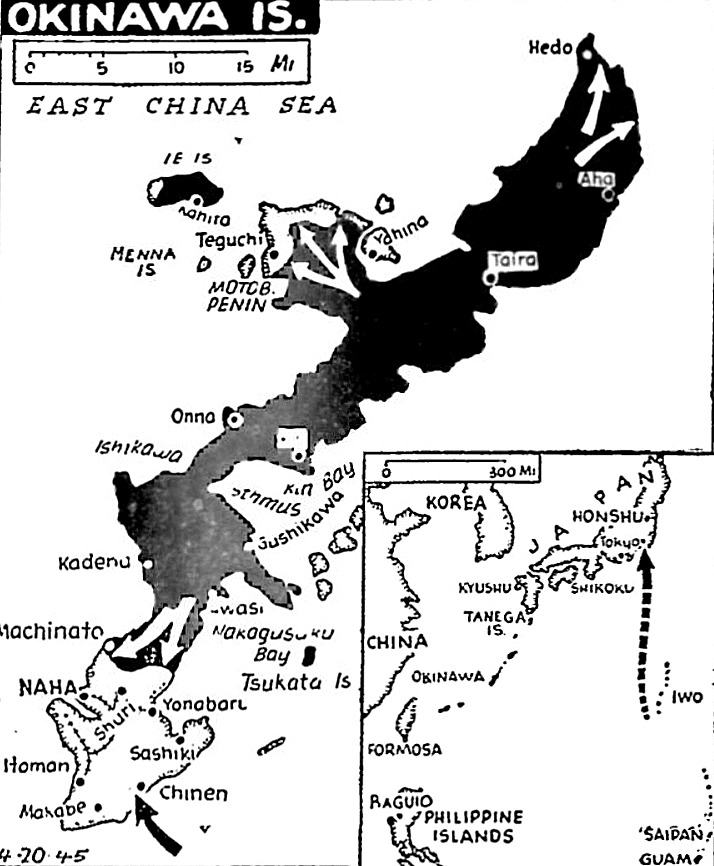U.S. Navy Department (April 20, 1945)
CINCPOA Communiqué No. 338
After a day of heavy attacks on the enemy’s fortified positions in the Southern Okinawa Sector, the XXIV Army Corps had advanced about 1,000 yards generally by the morning of April 20 (East Longitude Date). The 7th Infantry Division penetrated enemy defenses up to 1,400 yards in its zone of action near the east coast. Heavy naval guns continued to bombard enemy strong points and Marine and Army artillery supported the advancing infantry with carrier aircraft delivering close support. Most of Yonabaru Town was destroyed. The enemy resisted our attacks bitterly in all sectors of the fighting in the south.
On Ie Shima, Tenth Army troops continued to drive eastward against strong resistance from isolated enemy positions on April 20. Simultaneously, operations were began to destroy enemy forces holding Iegusugu Peak. At the end of April 18, 736 of the enemy had been killed on the island.
Patrols of the Marine III Amphibious Corps continued to cover the rugged country in Northern Okinawa on April 20 while operations against small groups of the enemy in Motobu Peninsula were continued.
In the early morning hours of April 20, several small groups of enemy aircraft approached our forces in the Okinawa Area and retired without causing damage.
The following is the complete list of ships sunk by enemy action in the Okinawa operation and the associated attacks on Japan from March 18 to April 18:
Destroyers:
- HALLIGAN (DD-584)
- BUSH (DD-529)
- COLHOUN (DD-801)
- MANNERT L. ABELE (DD-733)
- PRINGLE (DD-477)
Minecraft:
- EMMONS (DMS-22)
- SKYLARK (AM-63)
Destroyer Transport:
DICKERSON (APD-21)
Gunboat:
- PGM 18
- LST 477
- LCI (G) 82
- LCS (L) (3) 30
- LCT (6) 876
Ammunition Ships:
- HOBBS VICTORY
- LOGAN VICTORY
During the same period the following Japanese ships and aircraft were destroyed by our forces participating in the same operations:
- 2,569 aircraft destroyed
- One YAMATO-class battleship
- Two light cruisers
- Five destroyers
- Five destroyer escorts
- Four large cargo ships
- One medium cargo ship
- 28 small cargo ships
- 54 small craft
Numerous enemy torpedo boats, speed boats and other types of small craft.
Liberators of the 7th Army Air Force on April 19 bombed installations on Truk in the Carolines. On the following day, a search plane of Fleet Air Wing One sank a small sailing vessel in Truk Lagoon.
Army bombers of the 7th AAF also struck Arakabesan and Koror in the Palaus scoring hits on antiaircraft emplacements on April 19. Corsair and Hellcat fighters of the 4th Marine Aircraft Wing bombed miscellaneous targets in the Palaus and on Yap in the Western Carolines on the following day.
